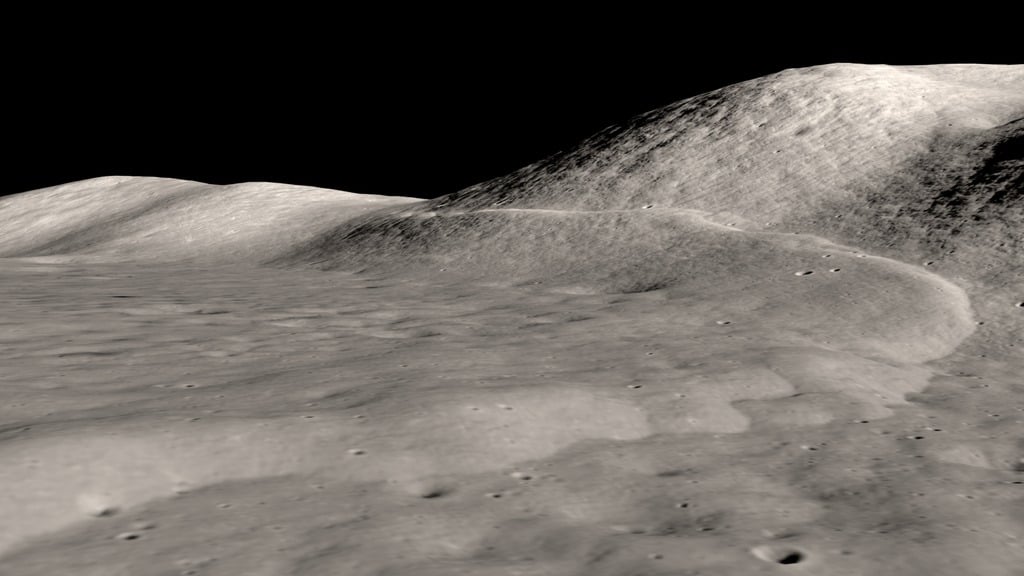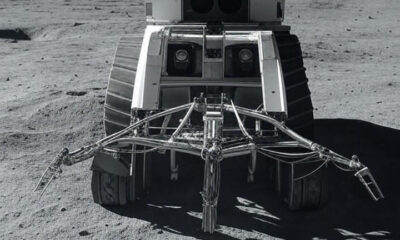Science
Moonquakes Threaten Safety of Future Lunar Bases

Moonquakes present a significant risk to the safety of future lunar bases, according to a recent study focusing on the seismic activity of the Moon. Research conducted by Thomas R. Watters, a senior scientist emeritus at the Smithsonian Institution, and Nicholas Schmerr from the University of Maryland, reveals that the Moon’s geological activity could impact the stability of long-term structures intended for human habitation.
The study specifically examines the Lee-Lincoln fault in the Taurus-Littrow Valley, the site of the Apollo 17 landing in 1972. It highlights how the Moon’s seismic history, which spans the last 90 million years, should inform the planning and construction of permanent lunar outposts. “The global distribution of young thrust faults like the Lee-Lincoln fault, their potential to be still active, and the potential to form new thrust faults from ongoing contraction should be considered when planning the location and assessing stability of permanent outposts on the Moon,” Watters stated.
The research utilized data collected from the Apollo missions, which provided crucial insights into the Moon’s geological past. Evidence of rockfalls and landslides in the Taurus-Littrow Valley indicates that even moderate quakes, such as those with a magnitude of 3.0, can lead to significant surface disturbances. This suggests that the Moon remains geologically active, which poses challenges for future missions.
Understanding the causes of lunar quakes is essential for assessing risks. Unlike Earth, where seismic activity is primarily driven by tectonic plates and volcanic processes, lunar quakes are mainly caused by tidal forces and the Moon’s ongoing cooling and contraction. As the Moon has cooled since its formation, it has shrunk by approximately 150 feet in diameter, leading to the formation of fault lines.
Watters and Schmerr’s study indicates that mission planners must consider these fault lines when establishing bases on the Moon. While short-term missions, like those conducted during the Apollo program, faced limited risk from quakes, permanent habitats will be exposed to a higher frequency of seismic events. “If astronauts are there for a day, they’d just have very bad luck if there was a damaging event,” Schmerr explained. “But if you have a habitat or crewed mission up on the Moon for a whole decade, that’s 3,650 days times 1 in 20 million, or the risk of a hazardous moonquake becoming about 1 in 5,500.”
This increased risk is not only limited to scientific missions. Countries like the U.S., Russia, and China are planning to establish nuclear power plants on the Moon to support their activities. Such installations could be vulnerable to seismic events, emphasizing the need for robust safety measures and careful site selection away from active fault lines.
The implications of this research extend far beyond immediate safety concerns. As lunar exploration intensifies, understanding the history of lunar seismic activity through paleoseismology becomes crucial. By gathering evidence of past quakes and analyzing recent seismic events, scientists can better determine safe locations for constructing habitats and power facilities.
The findings from Watters and Schmerr’s study underscore the necessity of integrating geological considerations into the planning of lunar exploration initiatives. As humanity prepares for a more permanent presence on the Moon, safeguarding structures against the inherent risks posed by moonquakes will be vital for the success of future missions.
-

 Technology5 months ago
Technology5 months agoDiscover the Top 10 Calorie Counting Apps of 2025
-

 Health2 months ago
Health2 months agoBella Hadid Shares Health Update After Treatment for Lyme Disease
-

 Health3 months ago
Health3 months agoErin Bates Shares Recovery Update Following Sepsis Complications
-

 Technology4 months ago
Technology4 months agoDiscover How to Reverse Image Search Using ChatGPT Effortlessly
-

 Technology1 month ago
Technology1 month agoDiscover 2025’s Top GPUs for Exceptional 4K Gaming Performance
-

 Technology2 months ago
Technology2 months agoElectric Moto Influencer Surronster Arrested in Tijuana
-

 Technology5 months ago
Technology5 months agoMeta Initiates $60B AI Data Center Expansion, Starting in Ohio
-

 Technology5 months ago
Technology5 months agoRecovering a Suspended TikTok Account: A Step-by-Step Guide
-

 Health4 months ago
Health4 months agoTested: Rab Firewall Mountain Jacket Survives Harsh Conditions
-

 Lifestyle5 months ago
Lifestyle5 months agoBelton Family Reunites After Daughter Survives Hill Country Floods
-

 Technology4 months ago
Technology4 months agoHarmonic Launches AI Chatbot App to Transform Mathematical Reasoning
-

 Technology3 months ago
Technology3 months agoUncovering the Top Five Most Challenging Motorcycles to Ride





















